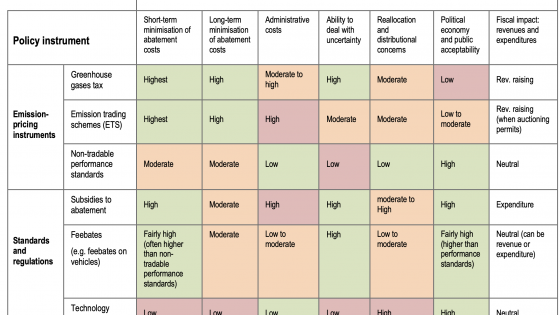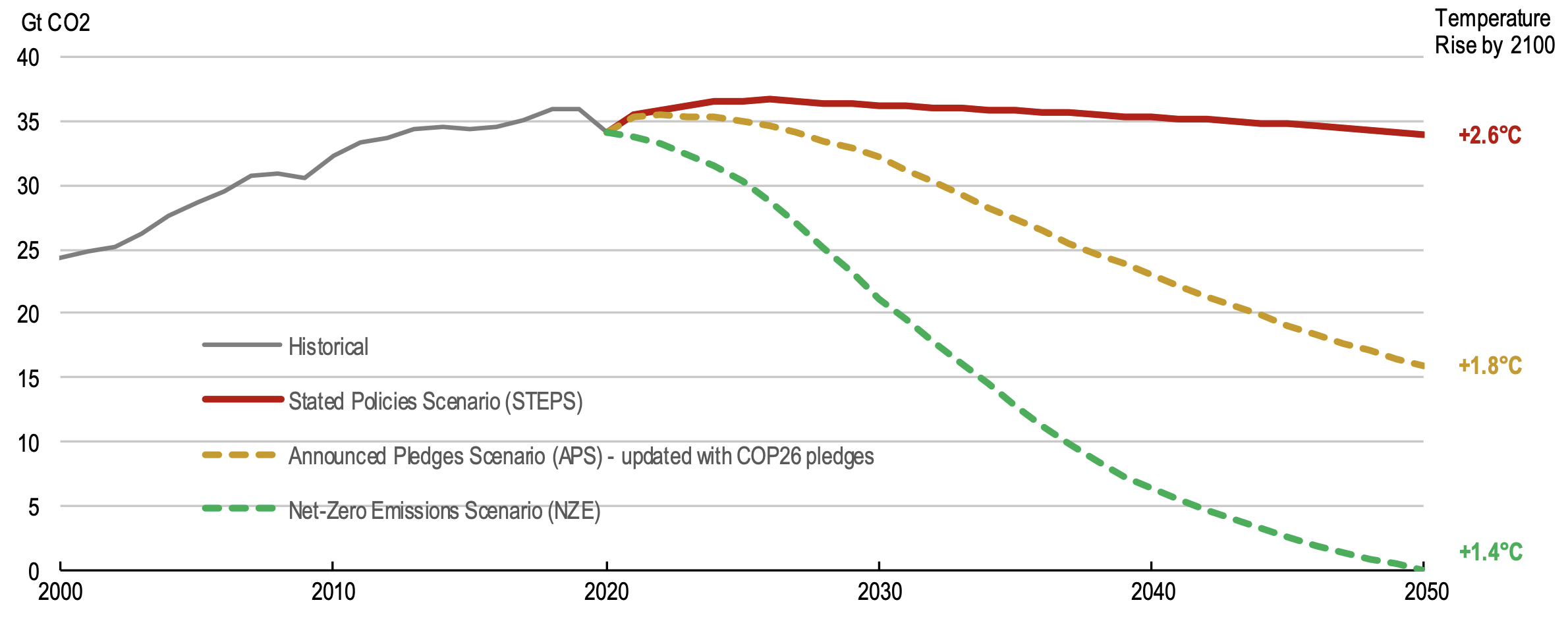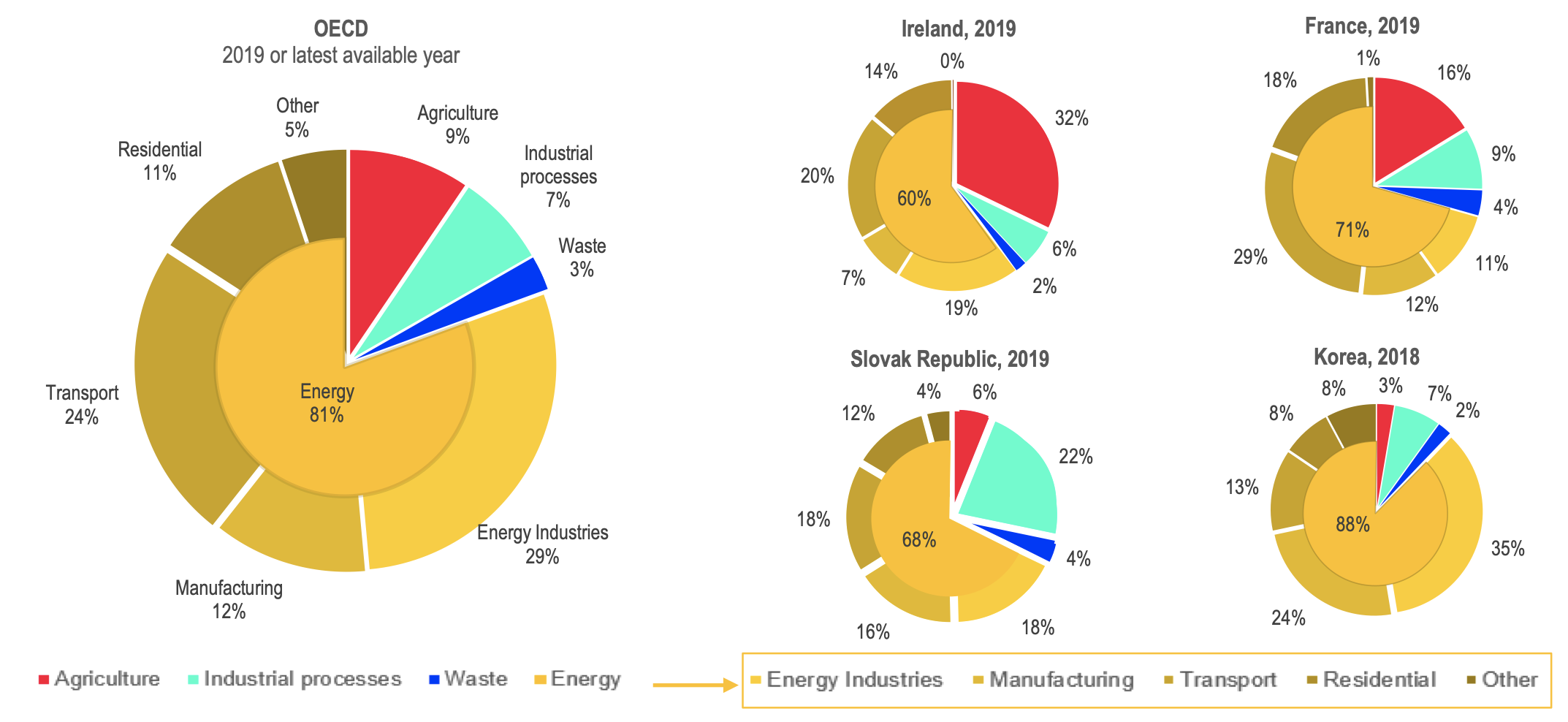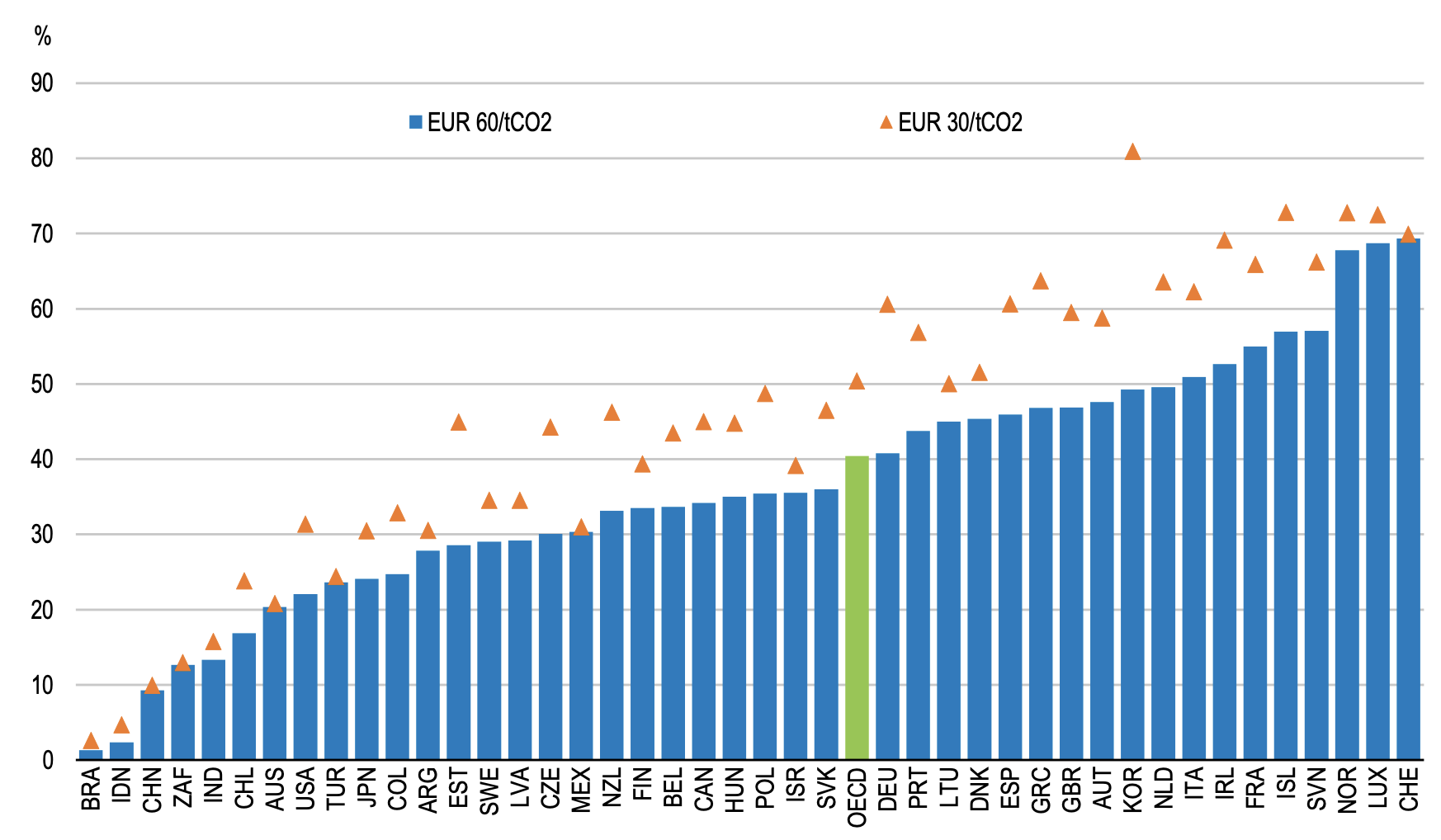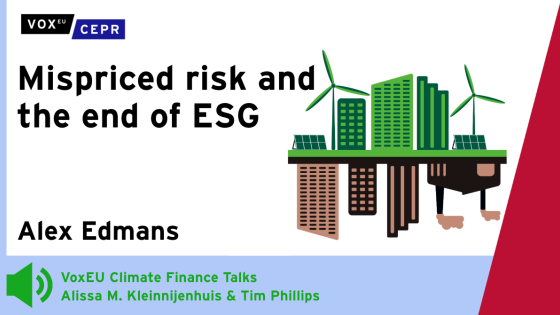Climate change puts the wellbeing of our and future generations in jeopardy (Intergovernmental Panel on Climate Change 2021). Despite novel commitments announced at the 2021 UN Climate Change Conference (COP26) in Glasgow and the months leading up to it, countries’ climate mitigation pledges and policies are still not in line with their ambitious emission-reduction targets and with the 2015 Paris Agreement goal of keeping the rise in world temperature “well below 2 degrees compared to pre-industrial levels” (Figure 1).
Figure 1 The world’s greenhouse gas emissions are not in line with net-zero by 2050
Scenarios of CO2 emissions over time (2000–2050) and respective expected temperature rise by 2100
Note: The Announced Pledges Scenario is updated with COP26 pledges as of November 3rd, 2021; the Net-zero Emissions Scenario shows the global energy-related emission pathway developed by the International Energy Agency, where technology, investments, and policies are deployed in line with the objective of reaching net-zero emissions by 2050. Expected temperature rises by 2100 are relative to pre-industrial levels and are subject to an upward risk due to uncertainties in the estimate and possible future changes in policy.
Source: International Energy Agency (2021a,b,c).
The expected economic and distributional costs of climate-mitigation policies deter policymakers from taking more decisive action. In the two years before the COVID-19 shock (2018–19), world real GDP grew by 6.4% (OECD 2022b) while CO2 emissions rose by 2.2% (Global Carbon Project 2021). In 2020, the lockdown measures implemented in many countries to contain the spread of the virus reduced global emissions by 5.2%. This yearly reduction is consistent with 2030 climate mitigation pledges, but it came at huge economic and social costs as world GDP dropped by 3.4% (OECD 2021b). Overall, this ‘natural’ experiment is a reminder of the need for new approaches and policies to reconcile decarbonisation efforts with growth and social inclusion (Weder di Mauro 2021).
Multiple market failures call for a comprehensive policy mix
Multiple market failures and contrasting policy objectives make the design of cost-effective decarbonisation strategies challenging. One major market failure concerns the negative externality that greenhouse gases (GHGs) produce, which creates a wedge between the marginal social costs and the private costs and results in prices that do not reflect climate damages. A second market failure concerns the under-provision by private markets of ‘green’ innovation and technological developments, due to knowledge being (to a large extent) a public good, especially in this domain (Dechezleprêtre et al. 2013).
Other market failures make these two problems worse. For example, co-benefits of reducing emissions – such as improved health and biodiversity – remain unpriced, thus weakening incentives to fight climate change; and network effects may hamper the deployment of ‘green’ technologies.
Governments can use a variety of policy instruments to reduce emissions (Caselli et al. 2021). In a new study (D’Arcangelo et al. 2022), we compare the performance of several climate policy instruments, belonging to two broad categories (emission-pricing instruments, and standards and regulations), across key criteria:
- lowering abatement costs in the short and medium-to-long term
- administrative costs
- ability to deal with uncertainty
- reallocation and distributional concerns
- political economy and public acceptability
- impact on the public budget (see Table 1 for key examples).
Table 1 Key climate policies examined via the assessment criteria
Note: The cell colours indicate how favourable the assessment criteria are for a given policy instrument (green: highly favourable; orange: medium favourable or mixed outcome; red: unfavourable; white: not applicable).
The overarching message of this exercise is that no single policy instrument is superior to the others along all these key criteria. This calls for a comprehensive climate policy mix that also includes complementary measures to enhance the cost-effectiveness and social acceptability of decarbonisation strategies. However, countries’ diverse emission sources (Figure 2), social preferences, and political constraints (such as tolerance to higher taxation, coverage, and the effectiveness of the benefits system and industrial structure) mean that effective and feasible policy mixes will vary across countries.
Figure 2 Sectoral shares of emissions vary across countries
Greenhouse gases emissions share (excluding land use, land-use change, and forestry) for selected OECD countries
Source: OECD, Green Growth Database.
Emission-pricing instruments
The first component of a comprehensive policy mix comprises emission-pricing instruments (Schlögl and Schmidt 2020, Gollier 2021). This component encompasses GHG taxes and emission trading schemes, such as the EU Emissions Trading System, as well as other incentive-based instruments such as taxes on polluting goods. An economy-wide uniform emission price is a cornerstone of mitigation strategies, as it is highly effective in reducing emissions in the short run. In practice, however, emission prices remain generally low (Figure 3), partly due to concerns over their distributional impacts and the public generally opposing them (Furceri et al. 2021, Rausch et al. 2011).
Figure 3 Most countries under-price their carbon emissions
Carbon pricing score, 2018
Though important, emission pricing may not suffice to decarbonise the economy, as they are ineffective when firms and households respond only weakly to price signals. In addition, emission pricing can magnify welfare losses of recessions unless it is time-varying (Benmir et al. 2021), and it does little to address coordination failures in innovation and licensing (Bessen and Maskin 2009). This limits knowledge spillovers and developments of new green technologies, with the risk of stymying the development of technologies with low abatement costs. Finally, international policy coordination is key to reducing risks of carbon leakage (Hoogendoorn et al. 2021, Bartram et al. 2021, Schmidt et al. 2021).
Standards and regulations
The second component of a comprehensive policy mix comprises standards as well as subsidies to accelerate the deployment of low-carbon technologies. These instruments may set a wide range of requirements, such as emission quotas, green certifications, and technology mandates. They can be especially effective in cases such as restricting and phasing out high-emitting activities or technologies within a certain date. Standards and regulations do not directly set emission prices, but the cost they entail can be seen as implicit emission prices (contrary to emission-pricing schemes, which set explicit emission prices).
Standards and regulations can effectively complement emission pricing and other incentive-based policies (Stiglitz et al. 2017), especially when they are technology-neutral (e.g. tradable performance standards). They can help to overcome coordination failures that hinder the diffusion of network-based ‘green’ technologies and innovation and can substitute emission pricing where firms and households are unresponsive to prices. Standards and regulations can also effectively deal with some market failures – caused, for instance, by myopic behaviour, financial constraints, and risk aversion – that emissions prices fail to address. For instance, energy-efficiency labelling can enhance the behavioural response elicited by incentive-based instruments.
Yet, ill-designed and uncoordinated regulations may greatly increase the cost of decarbonisation by blurring price signals, blunting economy-wide incentives, picking winners, and complicating performance monitoring. In these situations, they can result in high implicit carbon prices, detracting from the overall cost-effectiveness of decarbonisation strategies.
Complementary policies
Complementary and framework policies are the third component of a comprehensive policy mix. These include all those policies that do not directly aim to reduce emissions but instead lower the economic and social costs of policies doing so. Some complementary policies aim to accelerate the development and deployment of new abatement technologies (Acemoğlu et al. 2017). These include:
- R&D and innovation incentives
- measures supporting business dynamism (e.g. lifting barriers for firm entry, reducing barriers to trade, and reforming insolvency regimes) (De Haas et al. 2021)
- promoting data consistency and comparability of environmental, social and governance rating methodologies to crowd-in private capital (Ehlers et al. 2020, Elmalt et al. 2021, Bolton et al. 2021)
- higher investment to upgrade electricity and transport networks. For example, in Norway, the large increase in the number of electric-vehicle charging stations (600% between 2015 and 2021) has helped to reduce ‘range anxiety’ and supported electric-vehicle sales (OECD 2022a).
Other complementary policies aim to allay the distributional effects of climate policies and help people during the climate transition. A general empirical finding is that climate policies tend to be regressive (Zachmann et al. 2018). Recycling the revenues from emission-pricing schemes can help redress this and make climate policies more progressive. Though revenue earmarking is generally discouraged, as it creates rigidities in spending priorities, it can be a useful tool in the context of decarbonisation by strengthening commitment and clearly communicating how additional revenues will be used, thus building trust (Klenert and Hepburn 2018). In Switzerland, for example, the carbon tax bill passed in 2018 included allocating about two-thirds of the tax revenue to redistribution to households and firms (Office fédéral de l'environnement (OFEV), Confédération Suisse 2020).
Another example of a constructive complementary measure is the promotion of effective active labour market policies. Such measures can facilitate deep restructuring of the labour market that climate policies are likely to cause (Walker 2013). A successful example is the ‘flexicurity’ system in Denmark, which supports job mobility via active labour market policies, including training for skills demanded in green jobs (OECD 2021c).
Effective decarbonisation strategies require trusted institutions and transparent communications
Decarbonisation efforts will have pervasive effects on economies and societies and risk generating winners and losers (Chancel and Piketty 2015). A few elements may facilitate the identification of an effective policy mix that enjoys broad support (Furceri et al. 2021). First, reducing information and knowledge gaps is key to raising awareness of climate change and building trust among the public (van der Ploeg and Rezai 2018). This can be done, for example, by public communication and education campaigns with targeted combating of disinformation – without which significant opposition may arise.
Second, regulations that allow for transparent lobbying can prevent policy capture by interest groups who seek to hinder climate mitigation or distribute their costs unfairly (OECD 2021a).
And finally, effective stakeholder engagement in a transparent and trusted institutional setting can help to elicit, manage, and reconcile conflicting preferences and priorities. Denmark, the Netherlands and the UK have good examples of independent climate bodies that are responsible for assessing public views and providing independent policy recommendations to governments.
References
Acemoğlu, D, U Akcigit, D Hanley and W Kerr (2017), “Transition to clean technology”, VoxEU.org, 5 July.
Bartram, S, K Hou and S Kim (2021), “Tackling climate change requires global policies”, VoxEU.org, 3 May.
Benmir, G, I Jaccard and G Vermandel (2021), “A time-varying carbon tax to protect the environment while safeguarding the economy”, VoxEU.org, 20 August.
Bessen, J, and E Maskin (2009), “Sequential innovation, patents, and imitation”, RAND Journal of Economics 40(4): 611–35.
Bolton, P, S Reichelstein, M Kacperczyk, C Leuz, G Ormazabal and D Schoenmaker (2021), "Mandatory corporate carbon disclosures and the path to net zero", VoxEU.org, 4 October.
Caselli, F, A Ludwig and R van der Ploeg (2021), “No brainers and low-hanging fruit in national climate policy”, VoxEU.org, 8 October.
Chancel, L, and T Piketty (2015), “Carbon and inequality: From Kyoto to Paris”, VoxEU.org, 1 December.
D’Arcangelo, F, I Levin, A Pagani, M Pisu and Å Johansson (2022), “A framework to decarbonise the economy”, OECD Economic Policy Papers No. 31.
De Haas, R, R Martin, M Muûls and H Schweiger (2021), “Barriers to net-zero: How firms can make or break the green transition”, VoxEU.org, 19 March.
Dechezleprêtre, A, R Martin and M Mohnen (2013), “Knowledge spillovers from clean and dirty technologies: A patent citation analysis”, Centre for Climate Change Economics and Policy No. 151 / Grantham Research Institute on Climate Change and the Environment Working Paper No. 135.
Ehlers, T, B Mojon, F Packer and L A Pereira da Silva (2020), “Green bonds and carbon emissions: Exploring the case for a rating system at the firm level”, VoxEU.org, 12 December.
Elmalt, D, D Igan and D Kirti (2021), “Limits to private climate change mitigation”, VoxEU.org, 23 June.
Furceri, D, M Ganslmeier and J Ostry (2021), “Design of climate change policies needs to internalise political realities”, VoxEU.org, 7 September.
Global Carbon Project (2021), Supplemental data of Global Carbon Project 2021 (1.0) [Data set].
Gollier, C (2021), “Efficient carbon pricing under uncertainty”, VoxEU.org, 6 April.
Hoogendoorn, S, A Trinks and J Bollen (2021), “Carbon pricing and relocation: Evidence from Dutch industry”, VoxEU.org, 13 July.
International Energy Agency (IEA) (2021a), “CO2 emissions in World Energy Outlook scenarios over time, 2000-2050”.
IEA (2021b), “Temperature rise in 2100, by scenario”.
IEA (2021c), World energy outlook 2021.
Intergovernmental Panel on Climate Change (IPCC) (2021), Climate change 2021: The physical science basis, Contribution of Working Group I to the Sixth Assessment Report of the Intergovernmental Panel on Climate Change.
Klenert, D, and C Hepburn (2018), “Making carbon pricing work for citizens”, VoxEU.org, 31 July.
OECD (2022a), OECD economic surveys: Norway, Paris: OECD Publishing.
OECD (2022b), “Real GDP forecast” (indicator), OECD Statistics.
OECD (2021a), Lobbying in the 21st century: Transparency, integrity and access, Paris: OECD Publishing.
OECD (2021b), OECD economic outlook, Volume 2021 Issue 2, Paris: OECD Publishing.
OECD (2021c), OECD economic surveys: Denmark 2021, Paris: OECD Publishing.
Office fédéral de l’environnement (OFEV), Confédération Suisse (2020), “Taxe sur le CO2”.
Rausch, S, G Metcalf and J Reilly (2011), “Distributional impacts of carbon pricing: A general equilibrium approach with micro data for households”, VoxEU.org, 10 June.
Schlögl, R, and C Schmidt (2020), “Making the European Green Deal really work”, VoxEU.org, 23 November.
Schmidt, C, et al. (2021), “Pricing of carbon within and at the border of Europe”, VoxEU.org, 6 May.
Stiglitz, J, et al. (2017), Report of the High-Level Commission on Carbon Prices, International Bank for Reconstruction and Development and International Development Association, World Bank.
van der Ploeg, R, and A Rezai (2018), “How to deal with climate change deniers: Price carbon!”, VoxEU.org, 5 January.
Walker, W (2013), “The transitional costs of sectoral reallocation: Evidence from the Clean Air Act and the workforce*”, Quarterly Journal of Economics 128(4): 1787–835.
Weder di Mauro, B (2021), Combatting climate change: A CEPR collection, London: Centre for Economic Policy Research.
Zachmann, G, G Fredriksson and G Claeys (2018), The distributional effects of climate policies, Brussels: Bruegel.
